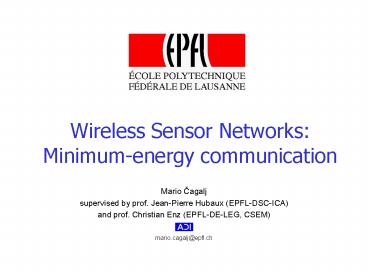Wireless Sensor Networks: Minimum-energy communication - PowerPoint PPT Presentation
1 / 19
Title:
Wireless Sensor Networks: Minimum-energy communication
Description:
Wireless Sensor Networks: Minimum-energy communication Wireless Sensor Networks Large number of heterogeneous sensor devices Ad Hoc Network Sophisticated sensor ... – PowerPoint PPT presentation
Number of Views:466
Avg rating:3.0/5.0
Title: Wireless Sensor Networks: Minimum-energy communication
1
Wireless Sensor Networks Minimum-energy
communication
2
Wireless Sensor Networks
- Large number of heterogeneous sensor devices
- Ad Hoc Network
- Sophisticated sensor devices
- communication, processing, memory capabilities
3
Project Goals
- Devise a set communication mechanisms s.t. they
- Minimize energy consumption
- Maximize network nodes lifetimes
- Distribute energy load evenly throughout a
network - Are scalable (distributed)
4
Minimum-energy unicast
5
Unicast communication model
- Link-based model
- each link weighed
- how to chose a weight?
- Power-Aware Metric Chang00
- Maximize nodes lifetimes
- include remaining battery energy (Ei)
6
Unicast problem description
- Definitions
- undirected graph G (N, L)
- links are weighed by costs
- the path A-B-C-D is a minimum cost path from node
A to node D, which is the one-hop neighbour of
the sink node - minimum costs at node A are total costs
aggregated along minimum cost paths - Minimum cost topology
- Minimum Energy Networks Rodoplu99
- optimal spanning tree rooted at one-hop neighbors
of the sink node - each node considers only its closest neighbors -
minimum neighborhood
D
C
B
A
7
Building minimum cost topology
- Minimum neighborhood
- notation - minimum neighborhood of node
- P1 minimum number of nodes enough to ensure
connectivity - P2 no node falls into the relay space
of any other node - Finding a minimum neighborhood
- nodes maintain a matrix of mutual link costs
among neighboring nodes (cost matrix) - the cost matrix defines a subgraph H on the
network graph G
C
A
B
8
Finding minimum neighborhood
- We apply shortest path algorithm to find optimal
spanning tree rooted at the given node - Theorem 1 The nodes that immediately follow the
root node constitute the minimum neighborhood of
the root node - Theorem 2 The minimum cost routes are contained
in the minimum neighborhood - Each node considers just its min. neighborhood
subgraph H
9
Distributed algorithm
- Each node maintains forwarding table
- E.g. originator next hop cost distance
- Phase 1
- find minimum neighborhood
- Phase 2
- each node sends its minimum cost to it neighbors
- upon receiving min. cost update forwarding table
- Eventually the minimum cost topology is built
10
An example of data routing
- Properties
- energy efficiency
- scalability
- increased fault-tolerance
- Different routing policies
- different packet priorities
- nuglets Butt01
- packets flow toward nodes with
- lower costs
11
Minimum-energy broadcast
12
Broadcast communication model
- Omnidirectional antennas
- By transmitting at the power level maxEab,Eac
node a can reach both node b and node c by a
single transmission - Wireless Multicast Advantage (WMA) Wieselthier
et al.
b
Eab
Ebc
Eac
a
c
- Trade-off between the spent energy and the number
of newly reached nodes
- Power-aware metric
- include remaining battery energy (Ei)
- embed WMA (ej/Nj)
13
Broadcast cover problem (BCP)
- Set cover problem
14
Distributed algorithm for BCP
- Phase 1
- learn neighborhoods (overlapping sets)
- Phase 2 (upon receiving a bcast msg)
- 1 if neighbors covered HALT
- 2 recalculate the broadcast cost
- 3 wait for a random time before re-broadcast
- 4 if receive duplicate msg in the mean time goto
1 - Random time calculation
- random number distributed uniformly between 0 and
15
Simulations
- GloMoSim UCLA
- scalable simulation environment for wireless and
wired networks
average node degree 6
average node degree 12
16
Simulation results (1/2)
17
Simulation results (2/2)
18
Conclusion and future work
- Power-Aware Metrics
- trade-off between residual battery capacity and
transmission power are necessary - Scalability
- each node executes a simple localized algorithm
- Unicast communication
- link based model
- Broadcast communication
- node based model
- Can we do better by exploiting WMA properly?
19
Minimum-energy broadcast
- Propagation model
- Omnidirectional antennas
- Wireless Multicast Advantage (WMA) Wieselthier
et al.
b
Pab
Pbc
Pac
a
c
- Challenges
- As the number of destination increases the
complexity of this formulation increases rapidly. - Requirement for distributed algorithm.
- What are good criteria for selecting forwarding
nodes? - Broadcast Incremental Power (BIP) Wieselthier et
al. - Add a node at minimum additional cost
- Centralized
- Cost (BIP) lt Cost (MST)
- Improvements?
- Take MST as a reference
- Branch exchange heuristic
- to embed WMA in MST


























![ESRT: Event-to-Sink Reliable Transport in Wireless Sensor Networks[Sankarasubramaniam et. al, ACM MobiHoc 2003] PowerPoint PPT Presentation](https://s3.amazonaws.com/images.powershow.com/6075243.th0.jpg?_=20201118051)




